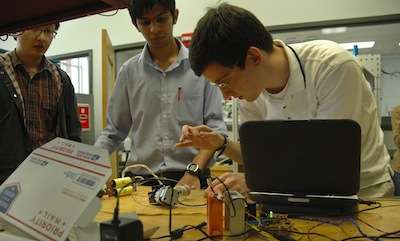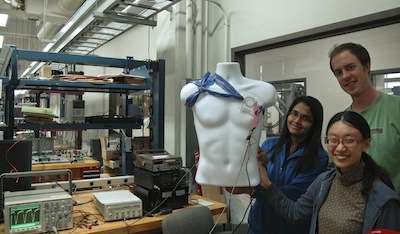Grad students explore wireless power transfer

A new course in spring 2014 used the concept of wireless power transfer to give electrical and computer engineering graduate students a primer in hands-on research and prototyping.
Electrical and Computer Engineering Assistant Professor Dan Ludois created the special-topics course ECE 905 for first- and second-year grad students, who worked in small groups to conceptualize and build projects including a pacemaker battery charger and a new heating element for 3D printers. The common factor is that each project harnessed the increasingly promising notion of using electric and magnetic resonance to transmit electric power through the air. The chance to work on a budding, novel technology might have drawn students in, but Ludois wanted his students to take away more fundamental lessons about communication and collaboration, elements he says can often get overlooked in a graduate education.
Ludois made a point of putting students with dissimilar backgrounds into groups. While many grad students focus on a problem defined by a faculty member, the ECE 905 teams were tasked with coming up with their own projects and making the case for their societal value. "That forced them to brainstorm as a group and say, 'What makes this worth doing?'" Ludois says.

The prototypes, presented as the semester wound down in May, span a variety of application areas. Tyler Graf, Jiayi Wang and Divya Natarajan created an implantable recharging circuit for artificial pacemakers, proposing to literally transfer power through a patient's skin. Wenbo Liu, Andrew Seltzman and Ashray Gururaja Manur used wireless power transfer concepts to create an induction-heating system for 3D printing, which they say will prove smaller and more efficient than the resistance heating elements common in 3D printers today. Cong Deng and Jiejian Dai worked together to create a sort of wireless charging table for mobile devices.
These students enter their graduate education with a great understanding of how to design something on paper. Ludois said the greatest challenge was getting them to make those design skills translate into real, functioning devices. He hopes to offer the class again in the future, perhaps every other academic year.
"On a deeper level, it was a class on how to be an effective researcher," Ludois says. "I told the students that I was experimenting on them in that regard."
Provided by University of Wisconsin-Madison



















